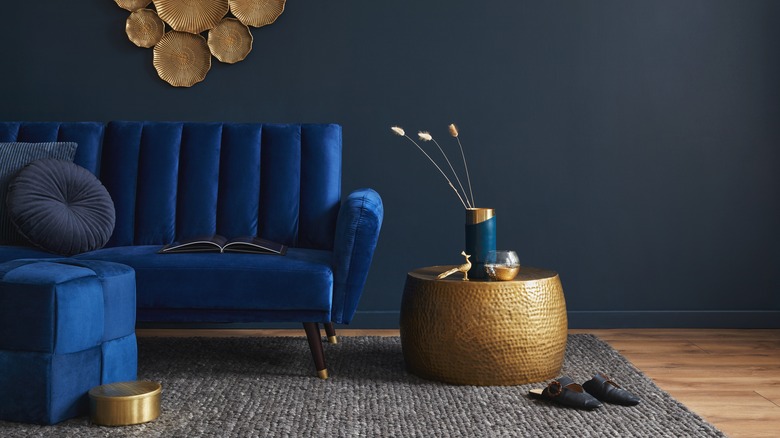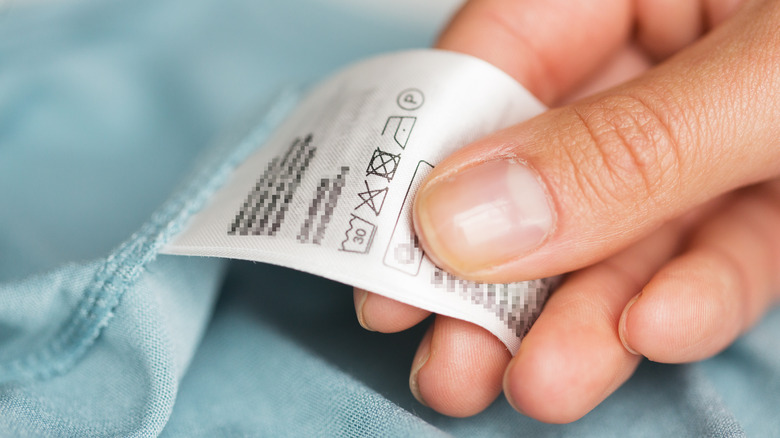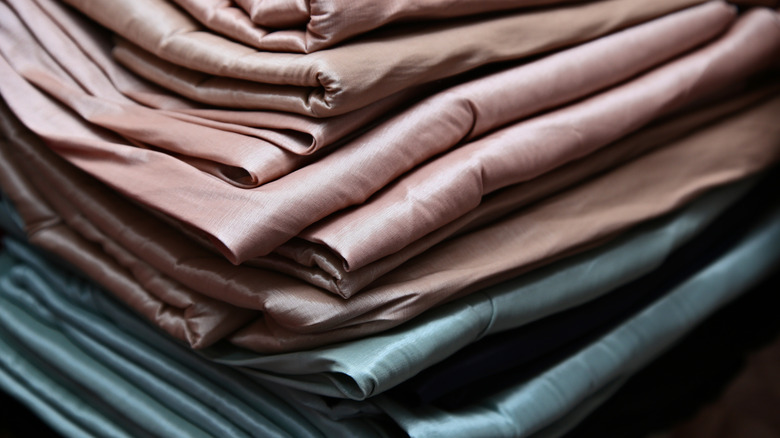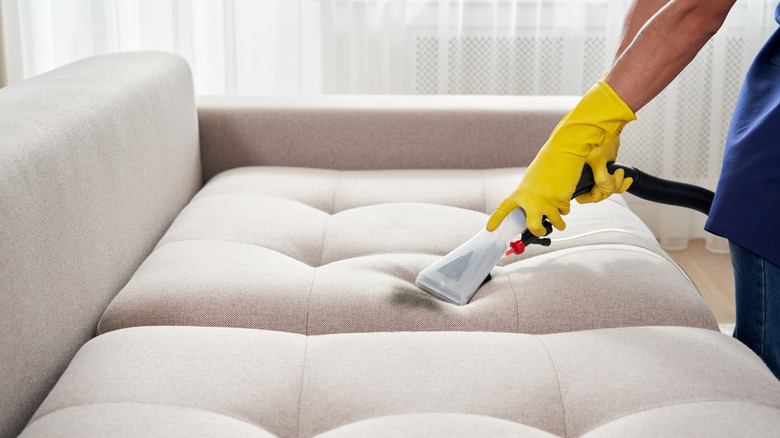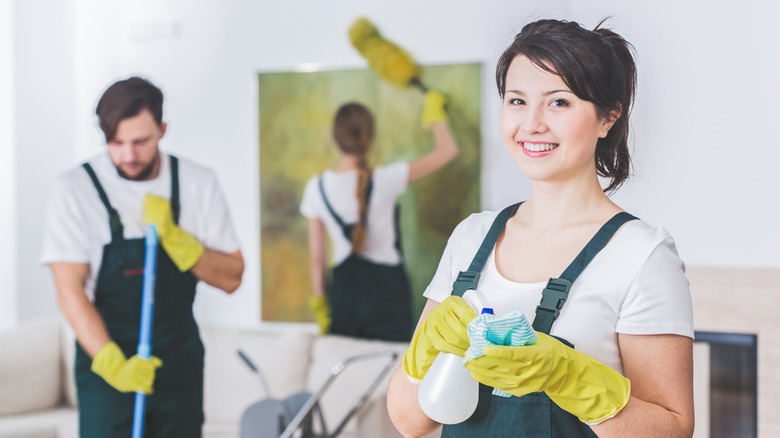How To Clean Acetate Furniture
If you're looking for a fancy piece of furniture without a high price, acetate furniture may be the perfect fit for you. According to Homelement.com, although acetate may worry consumers, given its common affiliation with harsh chemicals, the synthetic, man-made fabric is not harmful or dangerous in any way. To be exact, acetate fabric consists of cellulose acetate fibers, which simply makes the fabric look and feel smooth and silky with no harmful side effects.
The sewing blog TREASURIE further explains, saying that acetate is an artificial fabric commonly used as a less-expensive alternative to fabrics like rayon and silk. Along with its light elegant look, acetate fabric is also mold- and mildew-resistant; doesn't shrink, pill, or produce a high amount of static electricity; and can be purchased in a variety of gorgeous colors.
Like most fabrics, however, acetate also has a few downsides. Because acetate is a rather delicate fabric, it's not very durable; therefore, it rips easily, tends to stretch after a while, and can even melt if exposed to a specific amount of heat.
However, for its price, elegant look, and various positive features, the downsides to acetate can be more easily overlooked. If you're excited to try out some acetate furniture in your home, read on to learn what the best ways are to clean and maintain your new acetate furniture pieces.
Inspect the cleaning codes
Before diving head-first into your acetate furniture cleaning process, it's very important to first understand the cleaning codes that may be printed on your furniture's manufacturing label. These codes are important to examine before your start cleaning a piece of upholstered furniture because they show exactly what types of cleaning products you can safely use. Let's take a look at some of these codes and their meanings below (per Doerr Furniture).
-
S: The furniture piece can only be cleaned with a water-free, solvent-based cleaner or dry-cleaning product. This includes all areas of the couch, including removable cushion covers.
-
W: The furniture piece should only be cleaned with a water-based cleaner, like detergent foam. With this symbol, solvent cleaning products should never be used to clean any area of the furniture.
-
S-W: The furniture piece can be cleaned with either a mild solvent cleaner or a water-based product, like detergent foam. Before trying a method, however, test it out on a small inconspicuous spot to ensure it will not damage or hinder the look of your furniture.
-
X: The furniture piece should not be cleaned with a solvent-based or a water-based cleaner. Instead, stick to dry methods of cleaning, like vacuuming, brushing, or baking soda.
Understand what acetate fabric is
As mentioned before, acetate is a very light and smooth material that's meant to imitate silk or rayon. Per Bane-Clene, it's important to understand chemical compounds in acetate before attempting to clean any furniture made with the synthetic material.
First, you must understand that acetate fibers are very sensitive to strong chemicals, like alkaline solutions and oxidizing agents. This means you should avoid using detergents that may contain oxygen bleach, along with any other generally harsh chemical. Acetate fibers are also known to dissolve when exposed to acetone; therefore, keep acetone products, like nail polish remover, away from your acetone furniture piece.
Precautions must also be taken when exposing acetate furniture to heat and water. As explained by Utah State University Cooperative Extension, when exposed to heat, acetate fabric has a high tendency to melt. Similarly, when soaked in water, the fabric loses its strength. Luckily, acetate fabric is still known for being a somewhat moisture-resistant material that dries quickly and resists the build-up of mildew.
Clean according to the material
Because acetate is a fragile material, maintaining your acetate furniture must be done with extra precautions. For day-to-day maintenance, PRO Upholstery Cleaning states that low-moisture or completely dry cleaning techniques are the safest approaches.
If the piece of furniture is used on a regular basis, Clean and Simple Cleaning recommends vacuuming once a week, but says biweekly is also fine — it will depend on what your furniture needs. As a rule of thumb, whenever you vacuum the floor around and under your piece of furniture, you should take a little extra time to also vacuum off the furniture as well.
Wiggly Wisdom states the best and most efficient way to vacuum your upholstery furniture is with a brush attachment, which allows you to suck away all the dirt, hair, and grime that may be deeply embedded in the fabric of your furniture. Using a dry, stiff bristle brush is another way you can loosen up all the unwanted grime from your furniture item, then vacuum it away with any other vacuum attachment. However, regular cleaning of your acetate furniture should stave off this kind of buildup.
Along with vacuuming your acetate furniture pieces, you can also freshen up the material with baking soda. Without using a liquid of any kind, simply sprinkle some baking soda onto the surface of your couch and let it sit for a few hours. Then, after the few hours are up, take the vacuum and vacuum away all the baking soda to reveal a fresh and clean piece of acetate furniture.
Hire pros for a deeper cleaning
Even with the day-to-day maintenance of your acetate furniture, you may still come across on occasion spills, stains, or any other general need for deeper cleaning. However, despite the urgency you may feel to clean the deficiencies immediately on your own, it's highly recommended not to do so.
Despite the clear information given on the manufacturing label that states the cleaning methods the furniture's fabric can handle, per Maid Right, you should never attempt to deep clean your acetate furniture on your own, due to the high probability of causing harm or damage to the fabric.
Instead, PRO Upholstery Cleaning recommends using a professional upholstery cleaning company to properly clean your acetate furniture. Because acetate fabric must be cleaned with exact specifications, professionals will easily be able to target the exact levels of heat, moisture, and agitation to gain the best results regarding your acetate furniture piece(s).
